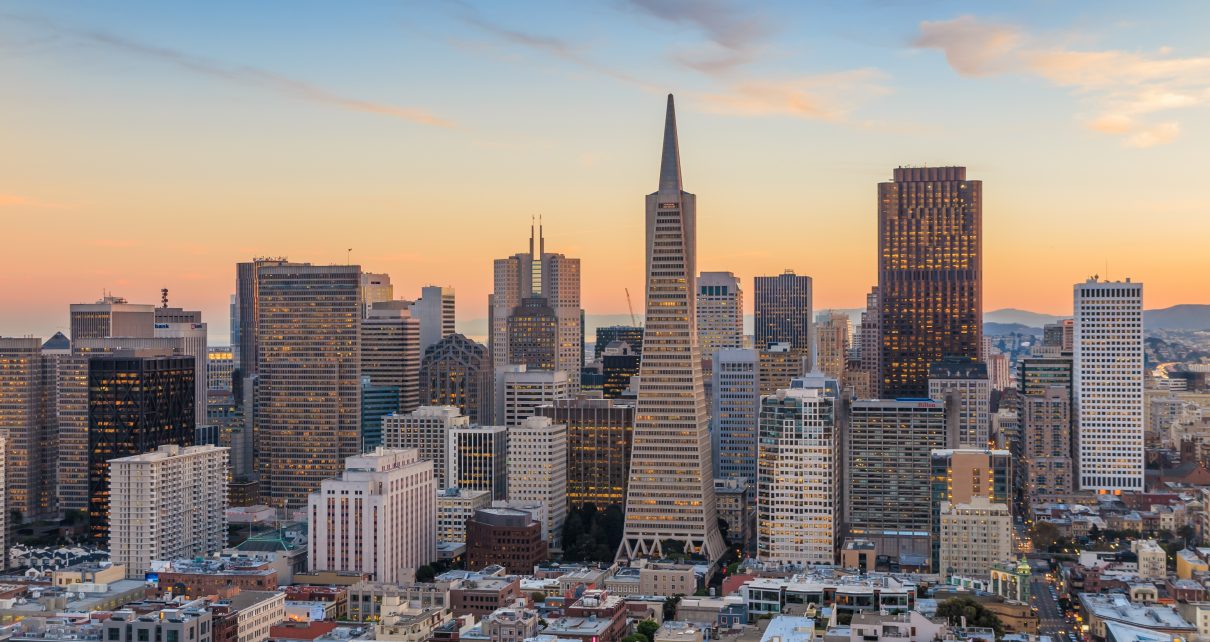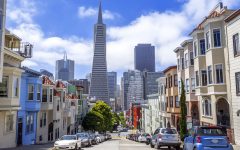
Beautiful view of business center in downtown San Francisco at sunset. (Photo: f11photo/Shutterstock)
San Francisco Office Vacancy Rates ‘Marginally Improves’ First Time in Five Years
San Francisco was around a 0% vacancy rate in 2019
By Evan Symon, December 17, 2024 4:16 pm
According to new preliminary data from real estate services company JLL, San Francisco saw their first drop in office vacancy since 2019 in Q4 2024, marginally improving from 34.5% last quarter to 34.3%.
Before the COVID-19 pandemic, San Francisco had a near 100% office occupation rate throughout the city, thanks in large part to the continuing tech boom and a steady demand for office space. However, with the COVID-19 pandemic, many companies began breaking leases to save money, while others embraced stay-at-home work and declined to continue using office space. Even after restrictions were dropped in 2021 and 2022, more companies switched to a work-from-home model or allowed more work-from-home positions, keeping many companies from returning to offices. In addition, high crime rates as well as a growing number of lease expirations by non-returning companies helped keep vacancy rates well above 20%.
In 2022 however, another major factor spiked vacancy rates yet again. Mass layoffs in the tech industry, which began in earnest in October 2022, wiped out the need for large office complexes and long-term leases. Fueled by economic uncertainty, high inflation, rising insurance costs, more people working from home, the rise of AI and automation, the continued rise of e-commerce, the rising crime rate in San Francisco, and many companies overcompensating, many large companies shed thousands of employees overnight. Tens of thousands of cuts came from longtime Silicon Valley stalwarts Google, Amazon, Intel, Lyft, Yahoo, Meta and Salesforce, with the second quarter of 2023 even producing many corporate, non-tech layoffs for companies in the city as well.
As a result, the average office vacancy rate in San Francisco jumped from 19% in 2021 to 27% in 2022 to 29.4% in the first quarter of 2023 to 31.8% in June. There was some good news during this time, with AI companies rushing into the city through a new tech field boom. In some cases, companies swooped in and leased 500,000 square feet of office space at once. However, that failed to break many trends. By September, the vacancy rate was at 33.9%, with crime forcing some tenants to switch to remote work and large scale renter companies such as WeWork also failing. By the end of November, that figure had risen to 35%, with December reaching 35.9%.
A fall in office vacancy rates
In 2024, the AI boom kept slowing down the vacancy growth rate. However, thanks to more companies cancelling leases, it still crept up. In Q1, the rate rose to 36.6%. And the recently released Quarter 2 results found that while vacancy growth was being curtailed even more, it still wasn’t enough to stop it from climbing, reaching 37% in July and still slightly climbing even higher in Q3.
While overall vacancy rates are still above 37%, office vacancy rates, a subset of the overall commercial vacancy rate, finally saw improvements on Monday. Large firms finally began taking over large swathes of vacant buildings. This included OpenAI taking over the former Old Navy headquarters of 315,000 square feet and UC San Francisco signing a deal for 300,000 square feet in the redeveloped Potrero Power Station in the last few months. This helped the now normal losses, leading to a slight improvement in the office vacancy rate, going from 34.5% in Q3 2024 to 34.3% in Q4 2024.
Many in real estate in San Francisco, however, have expressed caution at the slight dip. As more leases are set to end in 2025, vacancy rates could move back up if San Francisco doesn’t get more companies grabbing high amounts of vacant space, similar to what happened this quarter.
“Current tenant demand and future net absorption potential remain high,” said CBRE executive director Colin Yasukochi earlier this year. “Demand has been consistently replenished, considering seven leases exceeding 100,000 square feet and totaling about 1 million square feet occurred thus far in 2024.”
Building occupancy researcher Michelle Duggan added that “2025 can still be dangerous as we are getting those companies leaving high-cost leases from before the pandemic. We could also see more of what happened this year like how X moved out their headquarters. It is good that office leasing improved this quarter, but 2025 brings no guarantees.
“We also need to look at the overall vacancy rate, as we still don’t know those figures. And, we have to remember, no matter how much they can improve, San Francisco was around a 0% vacancy rate in 2019. It is going to take a long, long time to get anywhere even close to that. I’ll use a football analogy. The improvement this quarter is like a team scoring a field goal after giving up like 10 touchdowns.”
A general vacancy rate update for this quarter is expected to be released soon.
- Bill to Require Law Enforcement Disclosure if AI Was Used To Help Write Reports - August 7, 2025
- Gov. Newsom Files FOIA Request To ‘Expose True Cost’ Of L.A. Federal Troop Deployment for Anti-ICE Riots - August 6, 2025
- California Redistricting: How Newsom’s Plan Will Demolish Hard Fought GOP Gains - August 6, 2025





San Francisco needs an exorcist to rid it of the demonic Democrat party that has destroyed the once great city.
While the city coffers continue to the decline, the San Francisco Health Department hired a ‘fat positivity’ influencer to consult on “weight stigma and weight neutrality.” The new weight stigma czar, Virgie Tovar, is a self-described expert on “anti-weight-based discrimination.” Virgie Tovar’s website describes her as a “plus-size Latina author, lecturer, and leading expert on weight-based discrimination and body positivity” with over a decade of experience. In 2011, Tovar completed a Master’s degree focused on the study of how weight-based discrimination impacted lifelong gender trajectories in women of color. Tovar has been named one of the 50 most influential feminists by B*tch Magazine. She has received three San Francisco Arts Commission Individual Artist Commissions, the Inspire Award from Project HEAL, as well as Yale’s Poynter Fellowship in Journalism,” her website said.
The city is doomed?